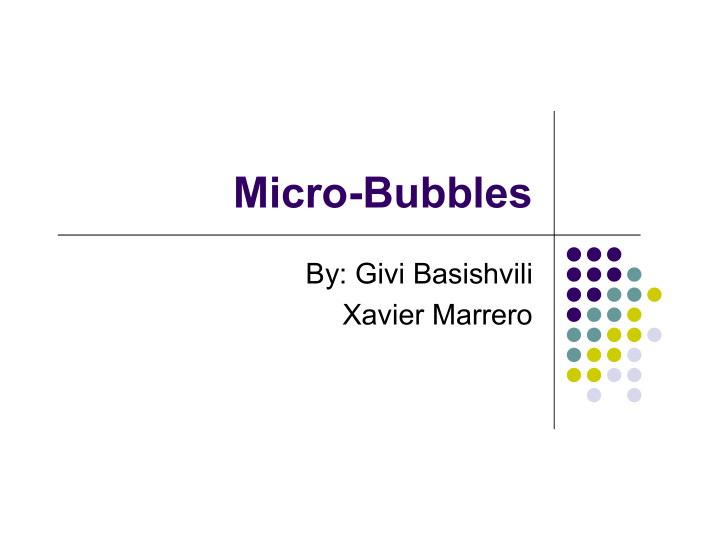



Micro-Bubbles By: Givi Basishvili Xavier Marrero
What are Micro-Bubbles? Small bubbles (>10µm; 0.000001meters) Can hold: Oxygen - Genetic Info (DNA) - Drugs - Used for Medical Purposes 10µm
Purpose Deliver Chemicals to specific areas. Targeted and popped by Ultrasound. Can be used to treat cancer, lung failure and other disorders.
Oxygen Bubbles Will keep patients with lung failure alive! Injected directly into blood. Oxygen acquired by Red blood cells and Hemoglobin.
Bubble Chemistry Components: - Lipid - Oxygen - Water Intermolecular Forces
Engineering Bubbles Lipid + Oxygen + Sound Waves = Oxygen Bubbles
Research Create stable Bubbles Determine best storing conditions. Determine bubble properties. Test in vivo (living organisms) Bubble
STABILITY TESTS Problem: Our micro-bubbles only last for 3-5 days so we want to make it as stable as possible. Perform different experiments to test whether leaving the micro-bubbles in refrigeration is more stable than leaving it outside in room temperature. First test: Leave the micro-bubbles outside in room temperature. Second test: Leave the micro-bubbles in a refrigerator.
STABILITY TEST’S RESULTS Gas % Over Time of Refrigeration vs. Room Temperature 60 50 40 Gas % Non 30 Refrigerated 20 Refrigerated 10 0 0 20 40 60 80 100 120 Time (hrs) The gas density decreased in both experiments but greatly in the room temperature micro-bubbles.
CONCLUSION FOR STABILTY TESTS The micro-bubbles left in the refrigerator were far more stable that the ones left outside in room temperature.
Storage: Rotation Hypothesis: Rotation will prevent bubble coalescence. Bubbles growing over time.
Data
Size Growth
Conclusion #2 Rotation = Higher Kinetic Energy = More Instability Collision with the wall also causes damage.
Future Tests Testing different lipid formulas. Vary engineering used to create bubbles. Determine the elasticity of bubbles.
References Sirsi, S. R., M. A. Borden. Microbubble compositions, properties and biomedical applications. Department of Chemical Engineering, Columbia University, New York. April 16, 2009. Ferrara, Katherine, Rachel Pollard, Mark Borden. Ultrsound Microbubble Contrast Agents: Fundamentals and Application to Gene and Drug Delivery. The Annual Review of Biomedical Engineering . 2007 http://www.research.philips.com/newscenter/archive/2008/backgrounders/080930- microbubbles.html http://www.safework.sa.gov.au/contentPages/images/ChemicalsPic.gif http://api.ning.com/files/FSiO4LhKSO6y92- wFwrcoGwiDXkpvVevmv9mNi3UQ6Ngb8HukzRAXJ4qyTSYRGH9KRAKj-aC4y449g3Y- SBSaAqCZxjvJJKy/engineering.jpg http://www.bradfitzpatrick.com/store/images/products/thumbs/bo002-cartoon-desk-clipart.jpg http://images.clipartof.com/thumbnails/5081-Female-Scientist-Holding-Pencil--Clipboard- Clipart.jpg http://kidneyinthenews.files.wordpress.com/2008/03/19443.jpg
Acknowledgements Prof. Mark Borden Ed Swanson Nathan Lee Chemical Engineering Department at Columbia University Dr. Sat Bhattacharya Harlem Children Society
Thank You for Listening. Any questions?
Recommend
More recommend